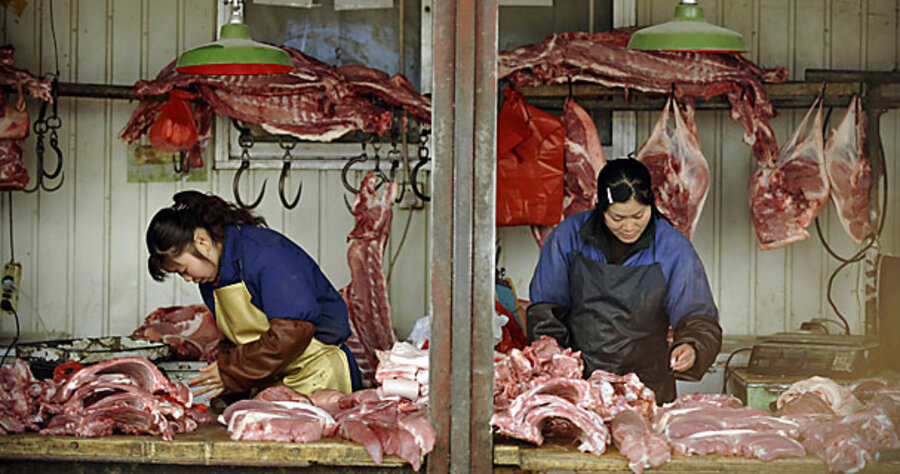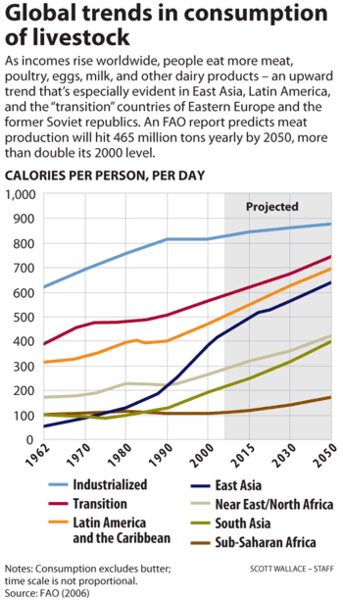Diet for a more-crowded planet: plants
Loading...
| New York
In the first quarter of 2008, grain prices climbed to a 30-year high. On average, food prices are 54 percent higher than in 2007. Grains have gone up 92 percent. Hungry mobs, hard-pressed to afford staples, rioted in Haiti, Mexico, and Bangladesh.
Experts point to a “perfect storm” of speculation, hoarding, drought in Australia, and diversion of grain to biofuels as culprits in the global food crisis.
But for some, the skyrocketing grain prices fulfill a longstanding prediction: A growing world population has more buying power. The newly affluent eat more meat. A rising share of the world’s agricultural output goes to animals. While grain supplies are more than adequate to feed everyone now, say experts, the current price spike shows that even an adequate supply doesn’t preclude hunger for the world’s poor. And in the future, a day may come when there isn’t enough grain for both humans and livestock – at least not at the US consumption rate. Add to this the environmental impacts of modern industrial-scale meat production, and many wonder: With a predicted world population of 9.5 billion by midcentury, are we all destined to be vegetarians?
Perhaps not entirely, say experts, but technological breakthroughs like lab-grown flesh notwithstanding, we’ll likely eat much less meat. And perhaps people in sub-Saharan Africa will eat a little more.
One-third of the world’s arable land grows food for livestock, and about 36 percent of world grain becomes animal feed. The problem, say experts, is the inefficiency of converting grain to meat. A pound of beef takes 7 pounds of feed to produce. For pork, the ratio is 1 to 3; and for chicken, 1 to 2. (Cold-blooded fish, which don’t need energy to maintain body temperature, are farmed more efficiently.)
Burden of the US model
“Using grain to feed cattle rather than people is putting enormous strain on stocks,” says Katarina Wahlberg, social and economic policy program coordinator at Global Policy Forum, an NGO in New York City. “Current consumption levels are unsustainable.”
The average American eats about 275 pounds of meat per year, says the United Nations’ Food and Agriculture Organization (FAO). Each American, in effect, consumes 1,765 pounds of grain yearly, says Lester Brown, author of “Plan B 3.0: Mobilizing to Save Civilization.” Only 220 pounds of that is consumed directly in foodstuffs like bread, pasta, and breakfast cereal. The rest is through animal products.
If everyone consumed grain at this rate, says Mr. Brown, today’s 2 billion-ton world grain harvest would feed only 2.5 billion people – two-fifths of the world population. If the world ate the way Italians do – 882 pounds of grain per person yearly – we’d feed 5 billion people. And if we all ate the way largely vegetarian India does (11-1/2 pounds of meat per person yearly, or 440 pounds of grain), our grain supply could feed 10 billion.
For Brown, this exercise has serious implications. Moral issues aside, hungry people lead to social unrest. And that has consequences for everyone.
“How many failing states before we have a failing global civilization?” he asks. “No one knows the answer because no one has ever been here before.”
World consumption trends are moving toward more meat, not less. From 1970 to 2005, meat production in the developing world more than quintupled, from 30 million to 162 million tons, says the FAO. If trends continue, global demand for meat will increase by half again by 2030.
By 2050, world meat production may more than double its 2000 level, to 513 million tons yearly.
Rising affluence drives the growing appetite for meat. According to a 2003 Proceedings of the National Academy of Sciences study, about 1.1 billion new consumers – people with significant disposable incomes – have emerged in recent decades. That’s in addition to the 850 million consumers already in rich countries. They all want meat.
As these newly affluent consumers have increased their meat intake, they’ve also grown less healthy. Some 1.6 billion adults around the world are now overweight (400 million of them obese), says the World Health Organization. Yet some 800 million worldwide are chronically undernourished.
“There’s no need for hunger in the world,” says Polly Walker, MD, associate director of the Center for a Livable Future at the Johns Hopkins Bloomberg School of Public Health in Baltimore, Md. “There’s an equity issue here that should give us pause.”
Issues of grain scarcity aside, many say environmental impact alone is reason enough to rethink industrial-scale animal production. Livestock generate 18 percent of the human-produced greenhouse gases in the form of methane, more than the transportation sector.
“Changing our diet is essential if we’re going to get control of climate change,” says Peter Singer, a professor of bioethics at Princeton University in New Jersey. It’s also a simple and quick way to reduce one’s carbon footprint. “That’s something we could do straight away. We don’t need to invent renewable anything.”
The 2006 UN report “Livestock’s Long Shadow” concluded that animal production, as currently practiced, poses a range of threats that demand immediate attention, from land degradation to biodiversity loss. A subsequent report by the Pew Commission on Industrial Farm Animal
Production echoed these conclusions, adding that the routine use of antibiotics on livestock increases the risk of creating a drug-resistant “superbug.”
Even the oceans are affected by livestock production. In coastal waters, dead zones caused by nutrient runoff, much of it animal waste, are a chronic problem. And a growing share of the world’s fish catch now becomes fishmeal and fish oil, which ends up in animal feed.
High feed prices have made harvesting fish more profitable, says H. Bruce Franklin, author of “The Most Important Fish in the Sea: Menhaden and America.” The fish are often vital to their ecosystems. They eat massive numbers of smaller organisms and serve as food for larger ones.(The average 8-inch-long menhaden filters 4 to 7 gallons of seawater per minute, he says.) Removing these creatures can unbalance an ecosystem. “The oceans cannot sustain this kind of pressure,” he says.
Grazing important to many ecosystems
Many note that livestock need not compete with humans for grain, nor must raising them be destructive. Huge swaths of land around the world are suitable for grazing and little else. Ruminants – animals that digest grass – can turn the otherwise inedible plants into food for people. If done in a way that mimics the Great Plains bison migrations of yore, grazing – a natural part of many ecosystems long before cattle arrived – can enhance the ecosystem rather than degrade it, says John Ikerd, a professor emeritus of agricultural economics at the University of Missouri, Columbia.
“We have a tremendous potential to produce a lot more protein, and really produce it in a way that’s good for the land,” he says.
In many regions, like large parts of Africa, animals provide necessary protein that would otherwise be unavailable. There, livestock production should increase, says Pierre Gerber, coauthor of “Livestock’s Long Shadow.” Yes, environmental concerns are important, he says, but so is human welfare.
“It’s not because you have an environmental issue that you should stop production,” he says. “It’s because you have an environmental issue that you should manage it.”






